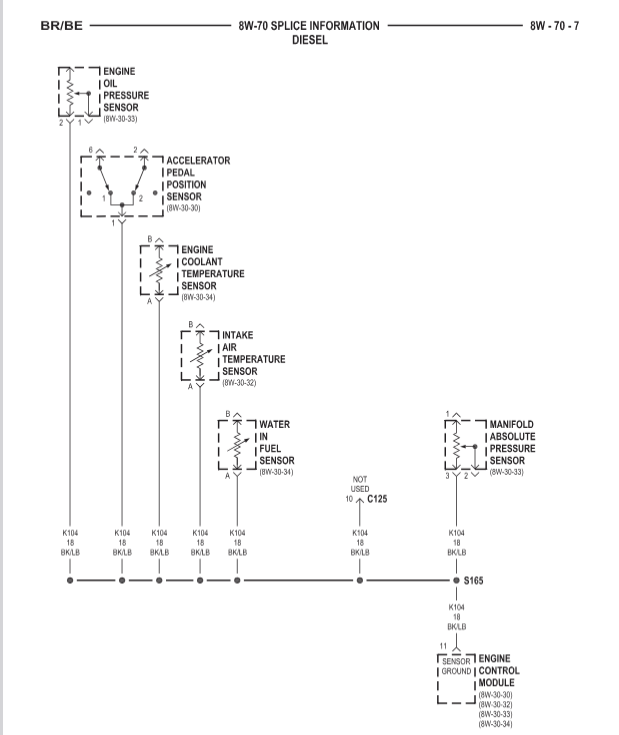
Everything posted by Tractorman
-
Death wobble for the 1st time ever in a 2nd Gen Cummins
That is good news. I didn't catch this on my first read. That would definitely be a contributor to "death wobble". John
-
Problem with idle cut off
I am very interested to see if replacing the intake gasket is really the fix, or is it just coincidental and something else got corrected? I can see how a leaking intake gasket could cause delayed power and low boost (your most recent complaint), but I don't see how it would affect idle or cause stalling. Just my thoughts. Keep us posted for any symptoms that may return: low idle rpm stalling John
-
Left turn radius much less than right turn
So, you are saying that the TIRES were pointed straight ahead and you counted the maximum turns of the steering wheel (about 4 1/4 turns stop to stop) and you centered the steering wheel (2 1/8 turns back to center from either stop)? And, after doing this, the drag link does not align with the Pitman arm? This tells me that the steering wheel is not centered in the steering box. If it is centered, the steering wheel can only be turned approximately 2 1/8 turns each way with the drag link disconnected. In fact, it seems like the steering wheel is a full turn off-center. Not sure what you expect to gain here since the Pitman arm is indexed to the sector shaft. The drag link should not make contact with anything. You will need to address this. There are mechanical steering stops located on the lower front side of each end of the axle housing. When your situation is corrected, your steering to full left and full right will contact these stops. John
-
Left turn radius much less than right turn
Something doesn't seem right here. Lots more questions. Can you give more detail about the event (forward speed, position of the steering wheel when contact was made)? Did you perform the T-style steering conversion yourself? Did you perform the alignment yourself? Did you ensure that the steering gear box was centered and tires were in the straight ahead position BEFORE you connected the drag link to the Pitman arm? Typically the Pitman arm is indexed in a manner that would allow for four different directions of installing (90° apart). That doesn't mean that yours is this way. Have you checked that your new steering linkage is not binding on something when you steer to the left? John
-
Left turn radius much less than right turn
Which tire was involved with the "bumped into a concrete pedestal thing?" It would take some serious force to strip the spines on the Pitman arm / sector shaft. Personally, I wouldn't drive the truck until the steering issue is figured out. Possibly, the Pitman arm is bent. Diagnosing this problem is going to be a bit more difficult since you swapped to the T type steering before you fixed the steering problem. Is the steering wheel centered when driving straight down the road? I would put the front end of the truck on jack stands and remove the front tires. Verify that the steering spindle "stops" contact the left and right axle "stops". If steering to one direction does not reach the "stop", then the steering gearbox can be over stressed on hard turns in that direction. If either steering "stop" cannot be reached, then something is still bent, or the steering gear box is no longer centered on the steering linkage after you did the steering conversion. John
-
Tracing disappearing oil
Observing soot at the end of the tailpipe is normal for this era of truck, especially if you have larger than stock injectors. Disconnect the compressor discharge plumbing from the turbo and inspect for an oily mess. Then, disconnect the exhaust band on the exhaust side and inspect for the same. It is possible. The hone pattern intentionally put into the cylinder walls is used as a mild abrasive to condition the outer wear surface of the piston rings for the first 1,000 miles or so of driving. During this period of time, the best mating of the rings to the cylinder wall will occur, resulting in the least oil consumption and least engine blow-by. Using a slippery synthetic oil during break-in reduces the effectiveness of the abrasive characteristics of honing the cylinder walls - it will have a more likely effect of polishing the piston rings and the cylinder walls, resulting in more oil consumption and more engine blow-by. Try performing the oil cap rattle test for the poor man's method of checking engine blow-by. John
-
Death wobble for the 1st time ever in a 2nd Gen Cummins
I would wait for him to drive the truck for at least a month plus a few hundred miles before I would consider it repaired. Many people who experienced death wobble have posted the repairs here on this site, only to experience the death wobble again weeks, or even months later. John
-
Pilothouse/RAM3500 build
👍! John
-
Death wobble for the 1st time ever in a 2nd Gen Cummins
Same method that I use. I have the engine running as well to allow the power steering to put a maximum amount of force to the linkages. Years ago, I set the caster to 4 1/2° positive. It was the best single steering performance improvement on my truck. John
-
Drop rpms
It almost sounds like the "high idle" is being activated. If you drive the truck with the coolant sensor disconnected, does the idle rpm stay where it should? John Some time ago, I did some research regarding this. It seems to be a bit of an anomaly that occurs on some vehicles when static electricity generated from the rubber part of the harmonic balancer jumps to the oil pan as a spark. The good news is that there is no cause for concern. John
-
Death wobble for the 1st time ever in a 2nd Gen Cummins
How does the track bar look. How are you testing the track bar or steering linkage? John
-
Drop rpms
P0122 - Accelerator Pedal Position Sensor Signal Voltage Too Low Are you familiar with the W-T ground reference modification? If so, have you done the modification? This modification addresses a potentially poor ground splice for the ECM and many other components. It addresses other wiring issues, as well. The wiring diagram below shows how many components use this splice. Here is the link to the Ground Reference Modification. I recommend to read thoroughly before beginning any work. https://mopar1973man.com/cummins/articles.html/24-valve-2nd-generation/engine/electrical/ground-reference-vp44ecmpcmpdc-plus-tc-lockunlock-r567/?&tab=comments#comment-177452 John
-
Drop rpms
Since only the ECM controls idle rpm, I think that you are going to have to provide some information regarding what your truck is and what repairs and symptoms that triggered high idle rpm. Details matter. John
-
2000 Cummins Surge/Dead Pedal
This is just my opinion here, so do not take this as fact. I have never been real concerned about maintaining a maximum specific AC voltage from the alternator. Nobody ever talks about this when diagnosing problems with vehicles that are not 2nd generation Dodge Cummins trucks. Why would they be an different? I am still running my original Bosch alternator (changed brushes twice, bearings once), but still have original diodes. I have checked for AC voltage at least three times in the last ten years. The readings have never be below .05 volts AC. However, I still am running with my original ECM, PCM, and a second APPS. The original APPS lasted for 289,000 miles until it failed (interestingly, with the same code as yours). The APPS I am now running is a Timbo and it has currently logged about a 113,000 miles. So, I can't say that this is absolutely not your problem, but I don't think that it is. Did you use a mulitmeter to check the idle validation switch activation when you loctited the throttle set screw? John
-
2000 Cummins Surge/Dead Pedal
That is a good way to test. Will be waiting to hear back. Also, have you verified that the mechanical set screw for the throttle cable is in good condition and that the throttle cable always returns to the mechanical stop when operating the throttle? John
-
2000 Cummins Surge/Dead Pedal
Interesting. I copied mine from my 2002 FSM, however your P0121 description actually seems more related to the symptoms that are occurring. What is the source of your information? John
-
2000 Cummins Surge/Dead Pedal
You could do that - it could confirm what your scanner is saying. Also, you mentioned that you are getting the P0121 code. P0121 (M) Accelerator Position Sensor (APPS) Signal Voltage Too Low APPS voltage input below the minimum acceptable voltage. You could check this voltage (5 volts supply) at the same time to see if it is fluctuating while the symptoms occur. The condition of wiring and wiring connections (both positive and negative) are crucial on these trucks - so, yes, it is possible for this to be the problem. John
-
2000 Cummins Surge/Dead Pedal
This doesn't mean that the APPS is faulty - it just means that there is an output signal at idle when there shouldn't be. Need to know where it is coming from. More troubleshooting needed. Since I don't know what your level of skill is with electricity, I will just start with the basics. Let's say you wanted to check the condition of the crossover cable by using a voltage drop test. First, you would need to understand what would be normal for the test results. There are two batteries (wired in parallel) and a starter on your truck. The starter will draw at least 400 amps when cranking. This means that 200 amps will be supplied by each battery. Consequently, when the starter is operating, the positive and negative cable of the driver side battery and the positive (crossover cable) and negative cables of the passenger side battery will be handling 200 amps each. By design there will always be a voltage drop during the starter operation - there has to be, otherwise current would not flow. The maximum allowable voltage drop in a complete positive circuit is generally .5 volts and in a complete negative circuit is generally .2 volts. The positive circuit has a higher allowable voltage drop because there are usually more switches and connection points than in a negative circuit. Voltage drop measurements can be taken at different points with a voltmeter while the circuit is under an electrical load. Voltage drop tests taken without the circuit under an electrical load will show results that are meaningless. So, back to performing a voltage drop test on the crossover cable. This usually works best using two people. One person will be in the cab and will crank the engine as instructed for a specified period of time. Be sure to be safe - truck in neutral / park and park brake set. Remove the fuel pump relay (in the PDC) for the VP44. This will allow the engine to crank continuously without starting. Set your voltmeter to a manual DC voltage scale of two decimals - example: battery shows 12.67 volts DC on the meter. Do not use the floating scale. Place and hold the positive lead onto the passenger side positive post of the battery (the actual post, not the clamp). Place and hold the negative lead onto the eyelet at the other end of the crossover cable. Your meter should read 0 volts. Instruct the other person to crank the engine for 10 seconds (no interruption). A reading of .1 volts or less during engine cranking indicates that the crossover cable is in very good condition. A reading of .7 volts (for example) during engine cranking would indicate that the cable needs to be replaced. This voltage drop test allows you to see the true condition of the crossover cable while over 200 amps are passing through - a real life situation. John
-
2000 Cummins Surge/Dead Pedal
It sounds like you have confirmed that a false signal is being generated in the APPS output circuit. It would stand to reason that the engine rpm's would increase if a signal is present. Back to a previous statement of mine that was meant as a question - are you using the starter for a heavy electrical load when performing your voltage drop tests? By the way, my throttle APPS output always showed zero at idle on the OBDLink scanner. John
-
20190107_154237.jpg.33f191c1cd5cfedeb21cb36d12797070.jpg
-
2000 Cummins Surge/Dead Pedal
Glad to see you are performing voltage drop tests. Which wire has the .5 voltage drop? I am assuming that you are using the starter for the load while reading these values. I have a Timbo APPS on my truck. I will test it with my OBDlink LX for behavior at idle when I go to town later, and then report back. John
-
July 2025 Truck of the Month – Enter Now!
Cool! John
-
1994 12v losing fuel prime after sitting a few days - FASS pump problems? Help?
You should know if you found the problem after letting the truck set for a couple of days. If it fires right up, then I think you have solved the issue. Do you have a fuel pressure in the cab of your truck? John
-
1994 12v losing fuel prime after sitting a few days - FASS pump problems? Help?
Why do you think your fuel pump is weak? If, in fact, the water separator was the problem, the symptoms that you had - matched the problem. Once enough air was introduced into the suction side of the pump, the pump would struggle to move fuel because the vanes would have been spinning in air - not fuel. This would especially be problematic if the fuel level was low, as the fuel would have to be lifted higher. During your testing, you loosened the downstream filter to help displace the air, but the lift pump still had a source to draw more air (the water separator). Then, when you corrected that issue, the lift pump still did not have any fuel around the vanes, consequently the lift pump still had some difficulty getting primed. Completely normal. Now that fuel is surrounding the vanes in the lift pump and the air leak is fixed, the lift pump will always be primed and ready to start the engine quickly. I think that your lift pump is fine. John
-
1994 12v losing fuel prime after sitting a few days - FASS pump problems? Help?
Exactly what I would expect. The voltage will bump to above 12 volts with the engine running and voltage at the battery rises to around 14 volts. You could try taking apart the lift pump. I have heard that there can be problems with the relief valve ball and spring - both with Air Dog and FASS. John





